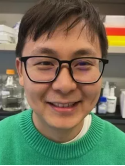Reconstitution of SPO11-dependent double-strand break formation Journal Article
| Authors: | Zheng, Z.; Zheng, L.; Arter, M.; Liu, K.; Yamada, S.; Ontoso, D.; Kim, S.; Keeney, S. |
| Article Title: | Reconstitution of SPO11-dependent double-strand break formation |
| Abstract: | Meiotic recombination starts with SPO11 generation of DNA double-strand breaks (DSBs)1. SPO11 is critical for meiosis in most species, but it generates dangerous DSBs with mutagenic2 and gametocidal3 potential. Cells must therefore utilize the beneficial functions of SPO11 while minimizing its risks4-how they do so remains poorly understood. Here we report reconstitution of DNA cleavage in vitro with purified recombinant mouse SPO11 bound to TOP6BL. SPO11-TOP6BL complexes are monomeric (1:1) in solution and bind tightly to DNA, but dimeric (2:2) assemblies cleave DNA to form covalent 5 ' attachments that require SPO11 active-site residues, divalent metal ions and SPO11 dimerization. SPO11 can also reseal DNA that it has nicked. Structure modelling with AlphaFold 3 suggests that DNA is bent prior to cleavage5. In vitro cleavage displays a sequence bias that partially explains DSB site preferences in vivo. Cleavage is inefficient on complex DNA substrates, partly because SPO11 is readily trapped in DSB-incompetent (presumably monomeric) binding states that exchange slowly. However, cleavage is improved with substrates that favour dimer assembly or by artificially dimerizing SPO11. Our results inform a model in which intrinsically weak dimerization restrains SPO11 activity in vivo, making it exquisitely dependent on accessory proteins that focus and control DSB formation. |
| Keywords: | meiosis; dynamics; initiation; complexes; meiotic recombination; distinct; spo11; dna topoisomerase-vi |
| Journal Title: | Nature |
| Volume: | 639 |
| Issue: | 8055 |
| ISSN: | 0028-0836 |
| Publisher: | Nature Publishing Group |
| Date Published: | 2025-03-20 |
| Start Page: | 784 |
| End Page: | 791 |
| Language: | English |
| ACCESSION: | WOS:001425295800001 |
| DOI: | 10.1038/s41586-025-08601-2 |
| PROVIDER: | Clarivate Analytics Web of Science |
| PROVIDER: | wos |
| PMCID: | PMC11922745 |
| PUBMED: | 39972129 |
| Notes: | Article -- Source: Wos |
Altmetric
Citation Impact
BMJ Impact Analytics
Related MSK Work











